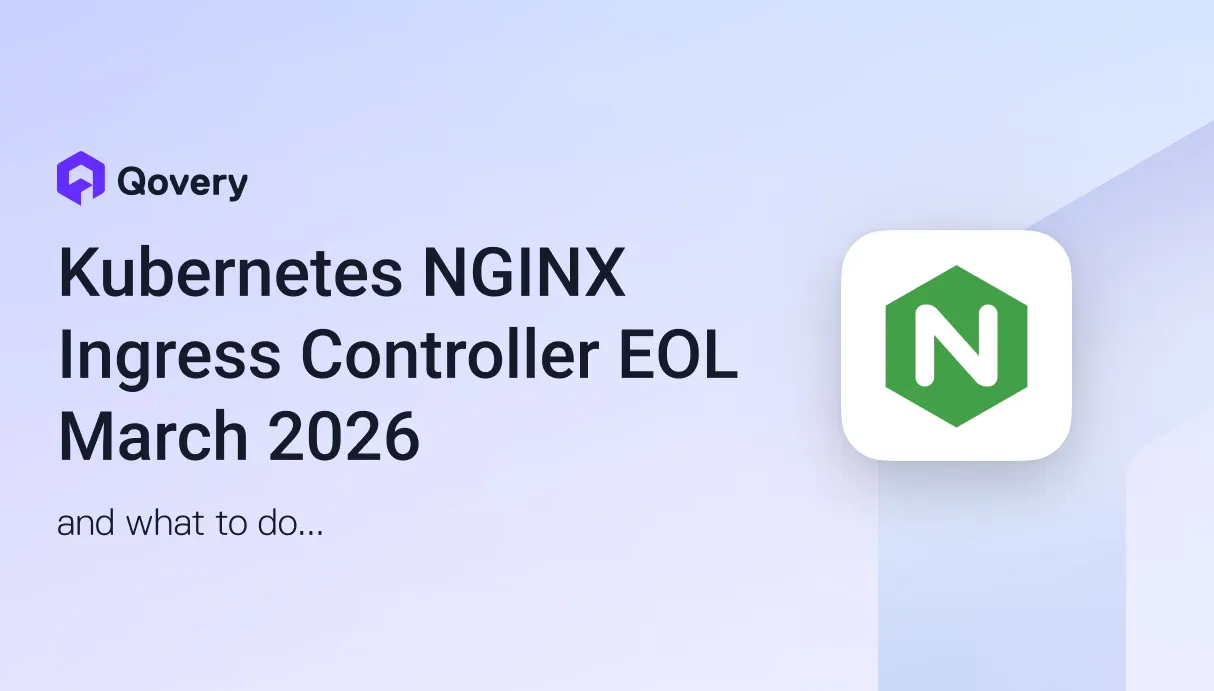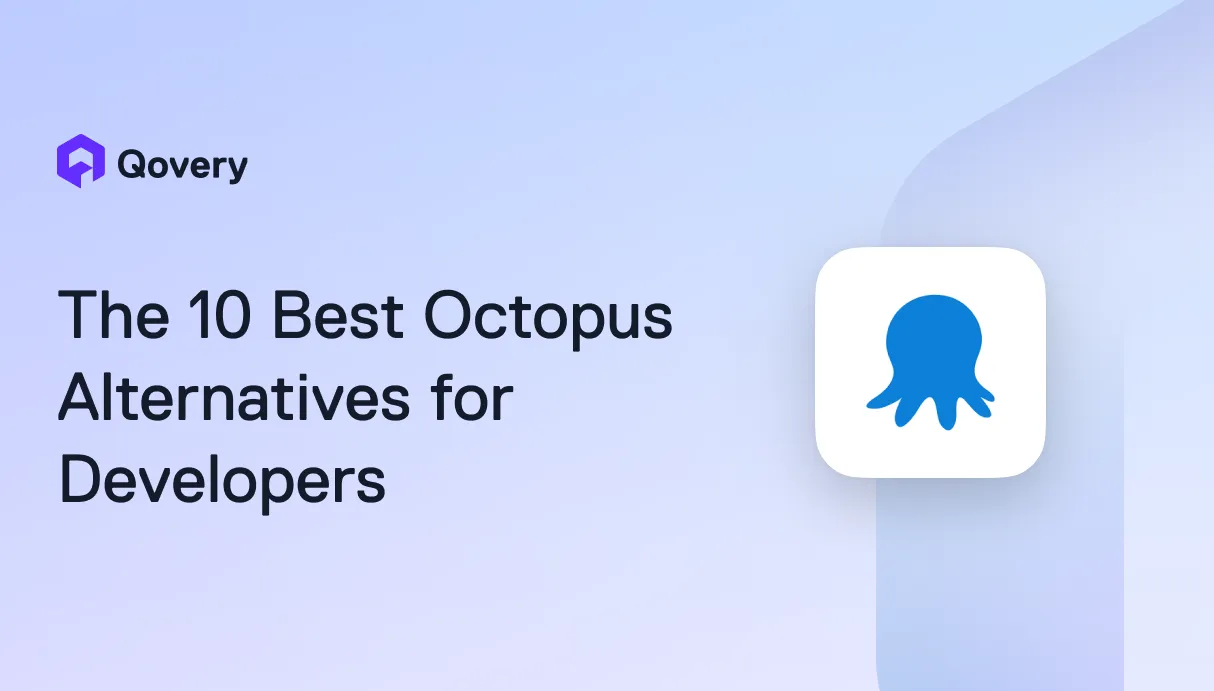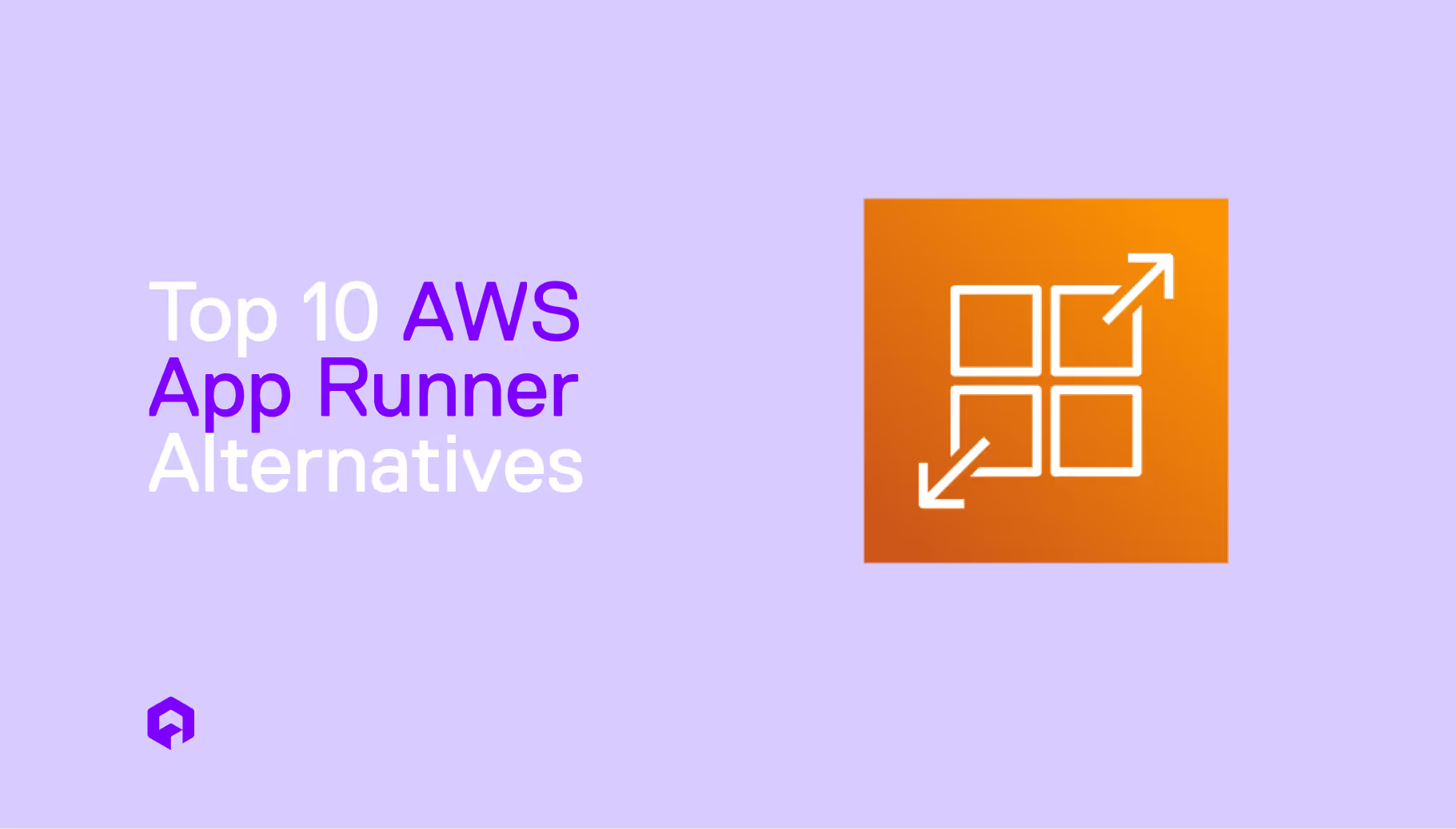

Master Kubernetes on Azure (AKS) with Qovery's Easy Migration



Key Points:
- Adopting Kubernetes on Azure (AKS) presents significant challenges. While AKS offers powerful cloud scaling, teams face steep learning curves due to the complexity of native Kubernetes, which requires managing hundreds of configuration files and a new CLI tool. Additionally, migration is often more difficult and time-consuming than anticipated, and ongoing operational overhead and cost management can be complex.
- Qovery simplifies and automates the entire AKS process. The platform makes migration easy by automatically provisioning all Kubernetes resources directly from a code repository. It abstracts away the complexity of native Kubernetes, providing a user-friendly interface and built-in best practices, which removes the need for deep expertise and reduces the probability of human error.
- Qovery offers tangible benefits for AKS users. The platform is developer-centric, providing teams with a simple, self-service experience that increases agility. It also ensures cost optimization through automated scaling and provides full control over the underlying Azure infrastructure, preventing vendor lock-in and allowing direct cluster access when needed.
Kubernetes on Azure (AKS) offers powerful tools for scaling applications in the cloud. Companies adopt AKS to run containerized workloads with Azure's security and compliance features. But getting there takes more work than most teams anticipate.
Teams run into real problems with AKS adoption. Moving workloads to the cloud implies some rewriting and extra configuration setup. Engineers need to learn new tooling, both at the infrastructure and application levels. Daily operations can be significantly impacted by adopting a new infrastructure, which can impact delivery for the company as a whole.
Qovery cuts through these issues. It handles migration, deployment, and operations automatically while you keep control of your Azure setup. Your team gets AKS benefits without the overhead of managing infrastructure yourself.
In this article, we’ll see what challenges lie ahead of adoption and how Qovery helps organizations onboard onto AKS easily. We'll go over the process and advantages that exist for a scaling company looking to setup a sustainable infrastructure.
Challenges of Adopting and Migrating to AKS
1. Complexity of Native Kubernetes
Running Kubernetes implies a lot of new configuration for each part of the infrastructure. Each deployment, service, and configuration needs its manifest. This new information represents a steep learning curve for engineers to onboard and understand the ins and outs of the platform. To run complex services successfully, most teams end up maintaining hundreds of configuration files for their services.
To manipulate those configurations and the clusters applications are running on, you use `kubectl`, a CLI tool used to access the Kubernetes API and manipulate resources. While powerful, this tool is complex as it requires various commands for checking pods, reading logs, or updating applications. The Kubernetes API has hundreds of resources to understand, which takes time for new team members to get comfortable with.
2. Migration Headaches
Getting apps onto a Kubernetes cluster isn’t straightforward, as the effort greatly depends on how your applications have been built up until now. You first require services to be Dockerized, which implies writing declarative configuration for each container and managing base images. Old applications often require major changes and thorough testing to make sure they function while in containers.
Every integration needs rework regarding storage and networking. Within a Kubernetes cluster, service-to-service communication can be complex, and persistent storage is specifically deployed. Applications are not exactly running like they would on a dedicated server, which can impact their performance.
Migration always takes longer than planned. Simple ports become complex projects when you find all the hidden dependencies. Scaling this effort to an organization can be greatly impactful on productivity.
3. Operational Overhead
Running a Kubernetes cluster means constant maintenance responsibility at different levels. At the lower level, this implies making sure that underlying machines are secure and up-to-date. It is also important to keep the cluster updated with new releases, as they bring reliability and security features.
At the application level, resources need to be monitored closely, making sure that allocations are correctly executed and that applications are scaled adequately to handle incoming traffic.
When things invariably break, debugging can be complex, especially with teams less experienced with the platform. Applications can crash for various reasons related to the cluster itself. This can impact delivery and product quality while taking time away from core product development.
4. Cost Management
AKS bills can add up fast, maintaining a correct scale is a conscious effort, and it is easy for a cluster to be badly provisioned. Getting the balance right takes constant tweaking and monitoring.
Every app requires different CPU and memory limits, which require monitoring effort to set correctly. Any bad configuration can either impact the correct functionality of a service or drive up costs.
Azure charges for everything. Nodes, disks, load balancers, network traffic. Without clear visibility, it is easy to have unused services adding to the bottom line at the end of the month.
How Qovery Simplifies the Process
1. Easy Migration
Qovery makes migration to AKS straightforward and automatic. It allows simply connecting a code repository to the platform and handles the provisioning of all Kubernetes resources automatically. The platform creates all application configuration and setup automatically, making it available and reusable in multiple environments easily.
Regarding infrastructure, managed clusters through AKS and Qovery are deployed effortlessly. Qovery handles all infrastructure provisioning automatically and configures the underlying clusters to be production-ready.
The platform removes the need for manual configuration and effort, reducing variability and the probability of human error.
2. Abstracted Complexity
Qovery exposes applications and their configurations through its Web UI and CLI. All Kubernetes details are abstracted and maintained through automations. This removes the need for deep expertise while accessing all features of the underlying infrastructure.
The abstraction also offers sane defaults, Qovery handles all the complexity and fine-tunes clusters with configurations that it knows will work at scale for your application. The platform harnesses all the possibilities of Kubernetes on Azure while offering safe guardrails for its users. All best practices are built in, making sure your applications are deployed in the best conditions for end-users.
3. Automated Deployments
With applications being onboarded directly through their repository, Qovery reacts to any change brought to the codebase. New branches and pull requests can automatically provision dedicated ephemeral environments while main branch changes trigger staging and production releases.
Multiple services can be built in parallel and deployed jointly if they are dependent on one another. Updates are deployed safely, making sure services roll out without any downtime or impact to customers.
Applications can be deployed to multiple environments easily, letting users test in production-like conditions. This increases confidence when releasing and shortens the feedback loop for engineers.
4. Simplified Management
All your services are visible at a glance. All applications, databases, and jobs show up in a single dashboard where you can track resources, costs, and performance without jumping between tools.
Deep control of the infrastructure is easily accessible, clusters can be scaled automatically depending on usage, making sure that costs stay lean during slow periods while also being able to handle traffic influx during busy periods.
Infrastructure changes can be experimented with easily without risking production environments. Each application can be duplicated in an isolated environment to perform tests and ensure that behaviors are as expected before exposing them to users.
1. The Qovery Advantage for AKS Users
Developer-Centric Experience
With Qovery, developers have complete agency over their application and environments.
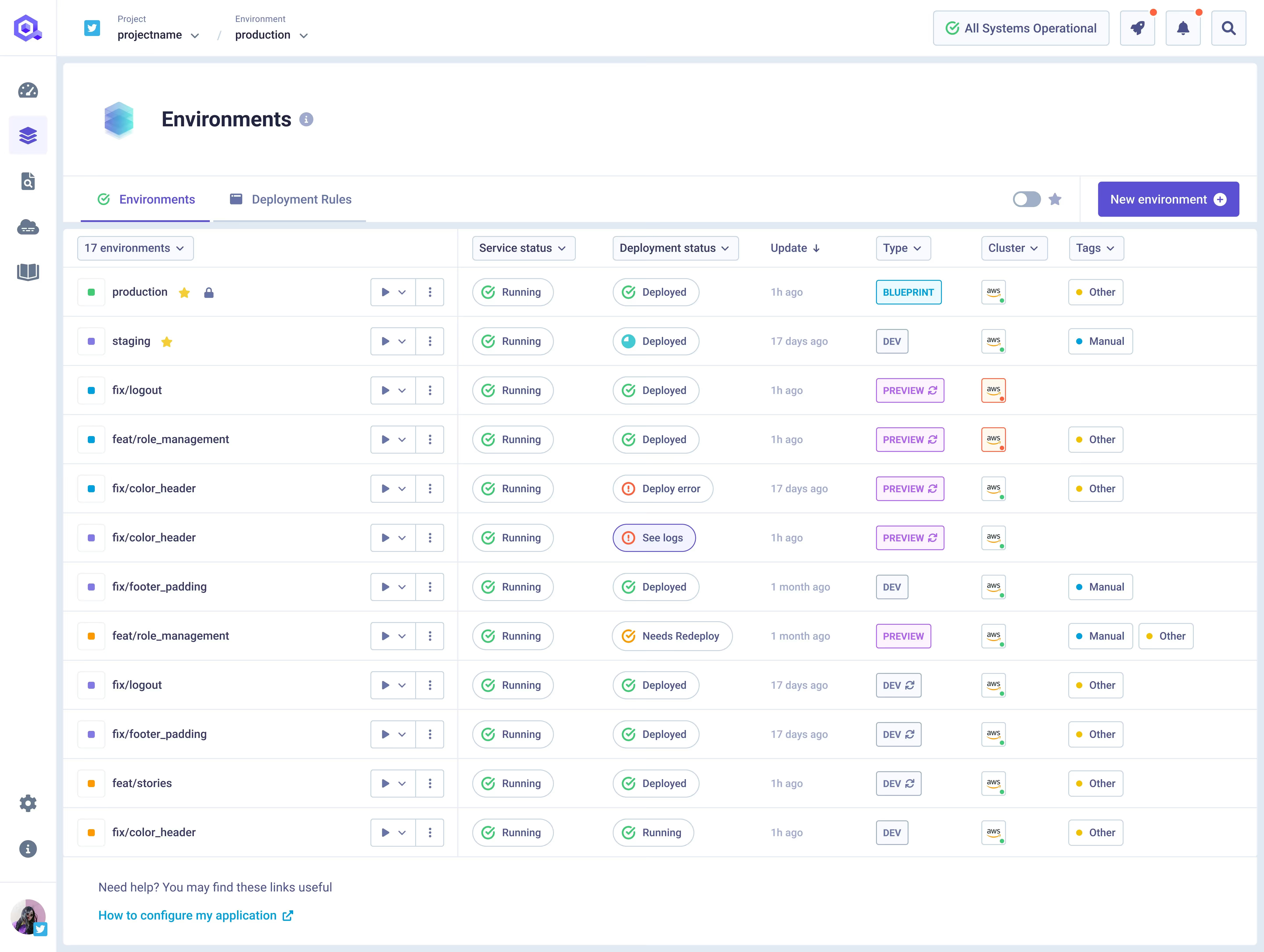
Qovery is opinionated and builds strong guardrails to standardize application development and ensure that no infrastructure issue can roll to production. It also features access controls that limit the permissions of each user. Developers get freedom within safe limits and can iterate quickly on their application in secure environments.
This approach aims at giving developers ownership over their applications, letting them experiment and develop new ideas fast, without dependencies on other teams or processes.
2. Cost Optimization
With Qovery, you can control and have visibility over your spending on AKS. Infrastructure is automatically managed to fit your needs and prevents overspending when provisioning resources.
Furthermore, the platform lets you implement autoscaling easily, improving right-sizing by automatically scaling down when utilization is low and deploying more resources when traffic is high. This proves to be a great lever to make costs lean, as close as possible to actual usage.
With Qovery, infrastructure spending becomes clear and controlled, letting teams scale and experiment without fear for their bottom line.
3. Full Control
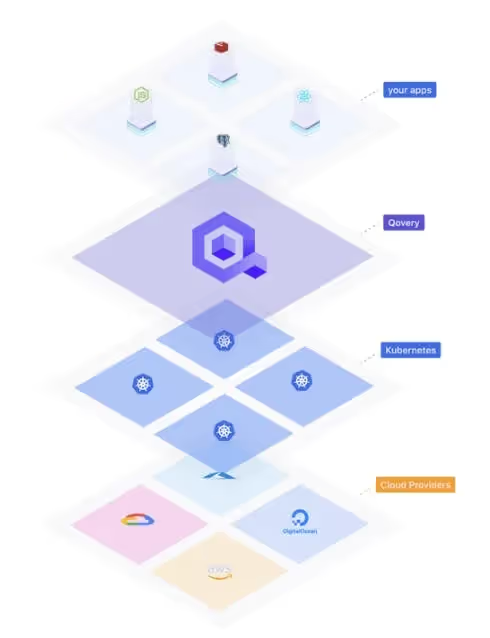
Using the platform, you still keep all your infrastructure running in the organization's Azure account, maintaining complete control over data, security, and compliance. There's no lock-in, and teams can export configs whenever needed.
Organizations can also access clusters directly when needed, using kubectl for debugging and customizing deployments if needed.
Qovery acts as an overarching layer over Azure and only extends the capabilities of the cloud-provisioned cluster. The deployed infrastructure is still under your control and can be customized to your needs when necessary.
A Step-by-Step Migration Guide
Step 1: Onboard on Qovery

Head to console.qovery.com and register for a new account. This will let you then create your organization, where you can manage your clusters and applications.
Step 2: Create Your AKS Cluster
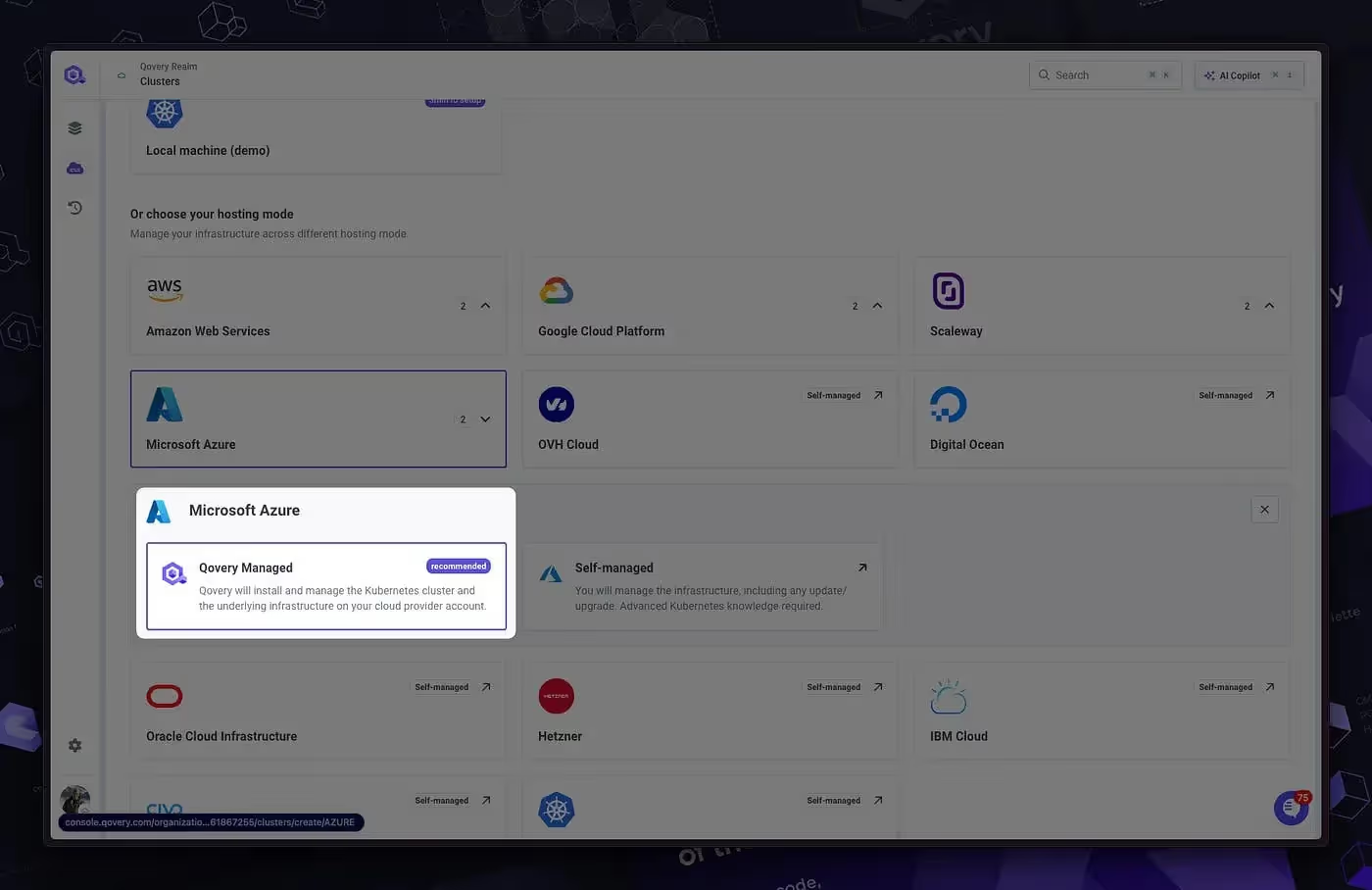
With one click, you can create a new cluster and link your existing Azure Account to the platform.
To connect your Azure account, make sure to create credentials for Qovery to access and manage your cluster. To learn more, see Creating Credentials.
Once onboarded, you’ll be asked to configure further configurations such as the size of the cluster or the region where you want it to run.

After the onboarding is complete, Qovery will get the AKS cluster ready and configured for deployment. Your cluster is now live, and you can start deploying applications.
Step 3: Deploy Your Application
To deploy a new application, use the Qovery Web Interface to add a new application using its Git repository. From there, Qovery can read the application files and get the deployment ready.
Choose the branch from which you want code to be released and which environment you want it to be deployed to. Once the configuration for your application is finished, including environment variables and resource requirements, select Deploy to get the service running on your previously created AKS cluster.
Learn More
See our detailed guide on deploying AKS clusters on Azure for more details.
Conclusion
Qovery's automated Kubernetes deployment tool provides the fastest path to mastering Kubernetes on Azure. The platform eliminates traditional AKS complexity while preserving its power and flexibility. Teams can quickly get up to speed and deploy applications onto the cluster using Qovery’s self-service tooling.
The benefits of such an easy onboarding are great for scaling companies. Reduced operational overhead frees engineers for product development while using best practices to improve reliability and security. Cost optimization ensures your Azure bills stay lean all throughout the process, helping you focus on your product and customers.
Engineering teams ship features faster with fewer production incidents. Qovery lowers the time-to-market and increases the efficiency of all engineers. This frees up time for them to innovate and address all customer needs.
Don’t let AKS complexity slow you down - start on Qovery today and see how fast you can get from code to production on Azure.

Suggested articles
.webp)



.svg)
.svg)
.svg)
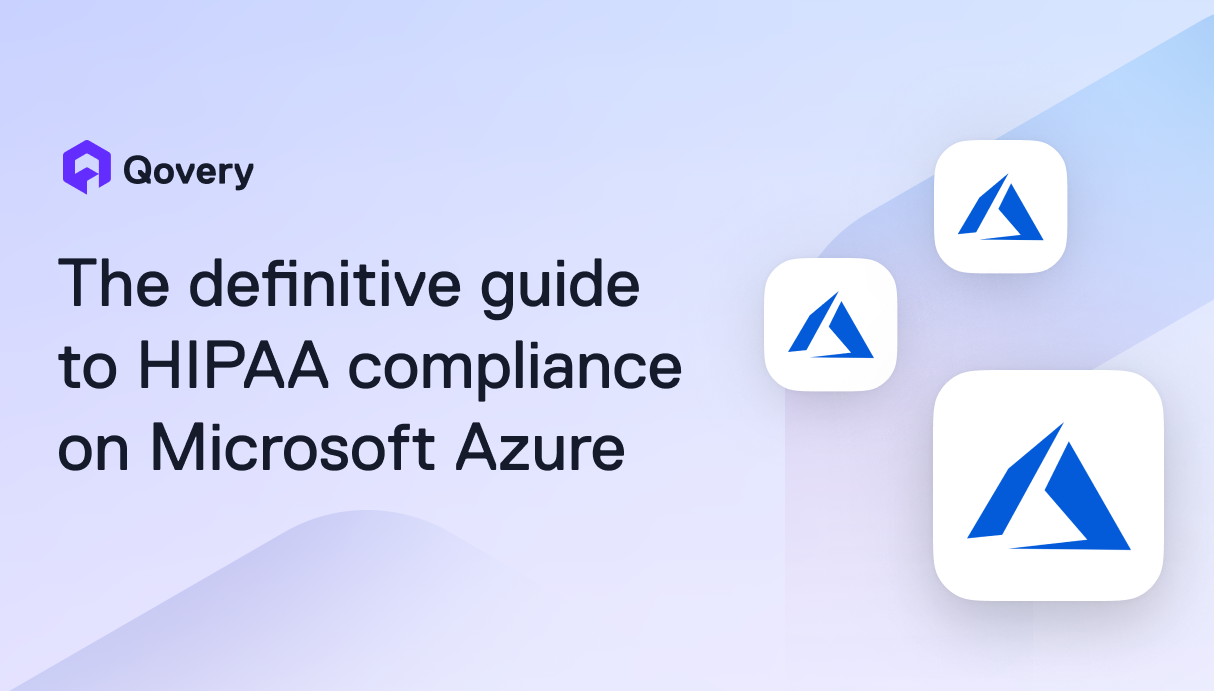

.png)
